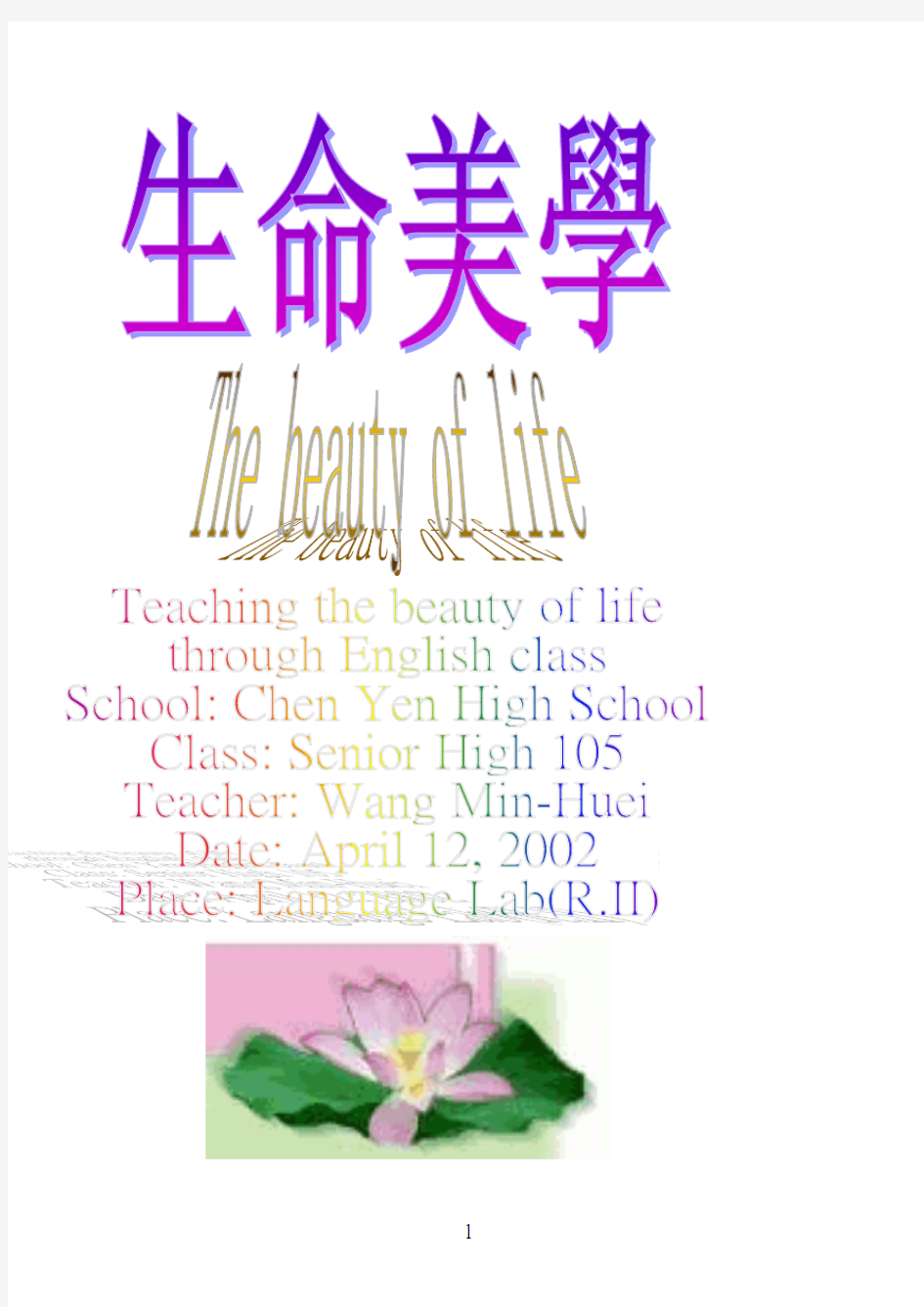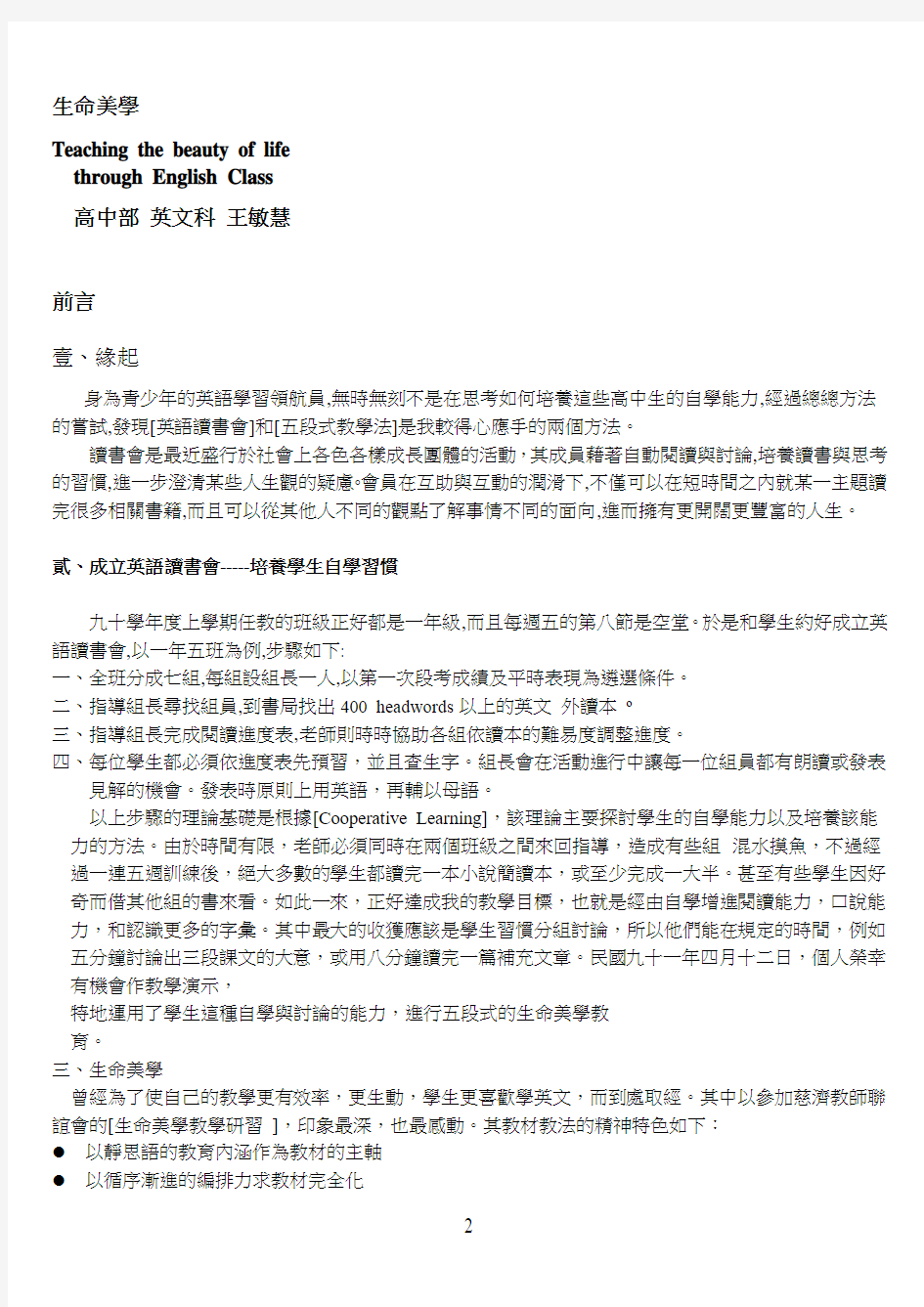生命美学


生命美學
Teaching the beauty of life
through English Class
高中部英文科王敏慧
前言
壹、緣起
身為青少年的英語學習領航員,無時無刻不是在思考如何培養這些高中生的自學能力,經過總總方法的嘗試,發現[英語讀書會]和[五段式教學法]是我較得心應手的兩個方法。
讀書會是最近盛行於社會上各色各樣成長團體的活動,其成員藉著自動閱讀與討論,培養讀書與思考的習慣,進一步澄清某些人生觀的疑慮?會員在互助與互動的潤滑下,不僅可以在短時間之內就某一主題讀完很多相關書籍,而且可以從其他人不同的觀點了解事情不同的面向,進而擁有更開闊更豐富的人生。
貳、成立英語讀書會-----培養學生自學習慣
九十學年度上學期任教的班級正好都是一年級,而且每週五的第八節是空堂。於是和學生約好成立英語讀書會,以一年五班為例,步驟如下:
一、全班分成七組,每組設組長一人,以第一次段考成績及平時表現為遴選條件。
二、指導組長尋找組員,到書局找出400 headwords以上的英文外讀本o
三、指導組長完成閱讀進度表,老師則時時協助各組依讀本的難易度調整進度。
四、每位學生都必須依進度表先預習,並且查生字。組長會在活動進行中讓每一位組員都有朗讀或發表
見解的機會。發表時原則上用英語,再輔以母語。
以上步驟的理論基礎是根據[Cooperative Learning],該理論主要探討學生的自學能力以及培養該能力的方法。由於時間有限,老師必須同時在兩個班級之間來回指導,造成有些組混水摸魚,不過經過一連五週訓練後,絕大多數的學生都讀完一本小說簡讀本,或至少完成一大半。甚至有些學生因好奇而借其他組的書來看。如此一來,正好達成我的教學目標,也就是經由自學增進閱讀能力,口說能力,和認識更多的字彙。其中最大的收獲應該是學生習慣分組討論,所以他們能在規定的時間,例如五分鐘討論出三段課文的大意,或用八分鐘讀完一篇補充文章。民國九十一年四月十二日,個人榮幸有機會作教學演示,
特地運用了學生這種自學與討論的能力,進行五段式的生命美學教
育。
三、生命美學
曾經為了使自己的教學更有效率,更生動,學生更喜歡學英文,而到處取經。其中以參加慈濟教師聯誼會的[生命美學教學研習],印象最深,也最感動。其教材教法的精神特色如下:
●以靜思語的教育內涵作為教材的主軸
●以循序漸進的編排力求教材完全化
●以發人省思的故事切入單元主題
●以體驗力行的學習單達成單元目標
以上特色可以經由教聯會的老師所研發的五段式教學展現,所謂五段是以五個教學活動來完成教學目標,分別如下:
●體驗---以境示教(以遊戲或動手做為主要的教學法)
●講述故事---借鏡反觀(老師或指定學生講述故事,英文課當然以英語講述為主,發音好的學生可以藉
此獲得更多肯定,而其他學生也多了聽力訓練的機會。)
●省思---完成價值觀念的澄清(如果有真人實事的錄影帶,此刻播放效果最好,接著分組討論)
●靜思---道德意識做深層的內化(此時老師設計的問題必須以學生本身的人生課題為主軸,例如:人之
所以不快樂,往往因為忘記自己所擁有的,卻忙於追求自己用不了的。現在讓我們來思考自己擁有什麼,看看自己是否很富有?)
●生活實踐---完成學習單(學習單的設計以能力行本次學習到的新觀念為主軸。)
經過多次的研習和教學,慶幸的是找到了比說教更生動的生命教育方法。靜思語是證嚴法師三十五年來依佛陀的教義,開啟無數人的智慧,拯救無數人生命的智慧法語。慈濟教師由於靜思語的薰陶,使自己的教學更人性化,更生動,遂發展出靜思語教學。
目前已出版的教材教法如下:
1.民國84年由靜思文化公司出版<妙手生華>上下兩冊,及<花開心喜>等靜思語教學故事書。
2.民國86年由靜思文化公司出版<杏壇飄香>靜思語教學的技巧、方法一書。
3.民國88年由靜思文化公司出版國小靜思語教學指引<大愛引航>,全套共十二冊,供六個學年使
用。
4.中學靜思語教材即將於五月份出版。
在完成整套的生命美學英語課程之前,曾分段小心實驗,直到證實這個
方法在陶冶學生的性情方面確實有潛移默化的效果,同時也兼顧了英語的
教學目標。以下所設計的教案,可以說是五段式教學的濃縮版,教師可以
視情況選用其中幾段來進行。此種教學方式以學生為主角,在老師事前用心設計的流程引導下,整節課學生不停地在聽、說、讀、寫。同儕之間的互動頻繁,學生的學習動機比單向的以老師為主導來得強烈。
Teaching plan
How do I teach my students the beauty of life through English Class
Learning Sheet
(A) Read the story and discuss the following questions.
1.What inspires you the most about the life of Hsieh Kun-shan?.
2. If you could talk to Hsieh in person, what questions would you ask him?
3.Decide whether each of the following adjectives is suitable for modifying Mr. Hsieh.
____1. friendly ____10. attractive
____2. brave ____11. shy
____3. nervous ____12. realistic
____4. romantic ____13. pompous(自負的)
____5. greedy ____14. wise
____6. homely ____15.mean
____7. childish
- ---p1----
Jing Si Aphorisms(靜思語)
1.不要小看自己,因為人有無限的可能。
Do not underestimate your ability; everyone has
unlimited potential.
2. 人要克服困難,不要被困難克服。
One must overcome difficulties, not be overcome by difficulties.
3. 勇氣不可失,信心不可無,世間沒有不能與無能的事,只怕不肯。Never lose courage. Never lose faith.
Nothing in this world is impossible when you are determined.
(A)Fill the blanks with Chinese meaning.
1. underestimate________
2.unlimited________
3. potential____________
4. overcome______
5. courage_____________
6.determined______
(B)Tell your family the story and share with them your favorite
aphorism.
_
(C ) Make a plan to quit your bad habit.
(D) Make a plan to develop your good habit.
Class:_________ No.____ Name:________ Group:_
-
結語
靜思語是許多人的精神食糧,是跨越宗教、種族的智慧法語。以靜思語作為〔main idea〕,來詮釋一篇感人的勵志文章,可以在學生的心田裡種下善念。在設計這樣的課程時,發現五段式教學可以很活潑地包容其他學習領域進去。例如:第一項是-體驗,學生在以口代手寫字和畫圖時,不僅可以對殘障人士生活上的不便感同身受,而且可以發覺人其實是有無限潛能的。這不就是時下所流行的”潛能開發課程”嗎?而在「講述故事」一項,學生可以達到聽與說的目的,至於台上以英語朗讀故事的學生可以在演示之前由老師指導「口語表達技巧」。值得一提的是實踐這一項,學生經由如此活潑生動的學習之後,可以在「學習單」的引導下,進一步反觀自己,找出生命的價值與意義。我的學生對這樣的課程反映熱烈,其中一封來自109班李淑萍給老師的肯定最多,跟大家分享如下:
──Ilike the way you taught these days very much! Because we can learn many things not only from textbooks, but also from extra activities. And that will bring us another illumination in our mind.
有一句關於教學的格言時時地在提醒我,教學一定要以學生為主體才能真正達到教學目標,那就是:
“Tell me and I forget
Show me and I understand
Involve me and I remember.”
謹以此小小的研究心得和大家分享,期待拋磚引玉,有更多的創意教學發表讓英語教學更有趣。
Appendix(一)
遠東版高中英文第一冊
第十一課選擇燦爛人生--------謝坤山的故事
Choosing a Bright Life:
The Story of Hsieh Kun-shan
課文(pp.166~168)
On October 4, 1996, a young artist named Hsieh Kun-shan appeared on television. He was receiving an award as one of Taiwan’s ”Ten Most Outstanding Youths of the Year.”Like the other winners, he had worked hard to achieve success. But there was something unique about Hsieh, something that really moved the audience as they watched him. It was this: Hsieh Kun-shan had no arms and only one leg..
And there was something else unique about him: although he was handicapped, he liked truly happy. Hsieh had a face that never seemed to stop smiling.
Seeing that smile, no one would guess how difficult life has been for Hsieh Kun-shan. He was born on June21, 1957, into a poor family in Taitung. When He finished elementary school, his father became sick. “I had to leave school and work in a factory to help make money for my family.”Hsieh said.
Life soon became even more difficult. At sixteen, Hsieh was in an accident at the factory. An electric cable fell on him and he passed out. “When I came round,” he said, “I found myself in the hospital, and my hands and right leg were black all over.” Doctors had to cut off both arms and one leg.
Life now seemed impossible. Suddenly, Hsieh could do nothing for himself, he could not even eat. He had to depend on his mother for everything. And every time his mother sat down to feed him, he saw tears in her eyes. “Usually, When a mother feeds her child, she is happy and full of hope,” Hsieh said,
”but not mine.”Seeing her pain, he made a promise: “I decided to live an active and meaningful life. I told myself not to mind what I had lost, but to treasure what I still had.”
Two years later, Hsieh found something that would give his life meaning---painting. Although he could paint only by holding the brush in his teeth, it still brought him happiness. “Suddenly I entered a world of my own,”he said. “When I painted, all the loneliness and pain disappeared”
When he was 23, Hsieh began to attend classes under the famous painter Wu Hsuan-san. It was difficult, but he did not give up. He practiced more than ten hours every day. “Hsieh is a superman,” his teacher said. “He worked hard and never complained.”In 1981, he held his first exhibition. His third exhibition, in 1985, won him a special award.
During this time, Hsieh also went back to school, graduating from senior high at 30. As a student, he proved that he could do everything by himself. He even carried his own books. But most of all, he impressed everyone with his pleasant personality . He always brought happiness to the people around him.
Hsieh’s optimism and kindness also won the heart of Miss Lin Shu-fen.
They were married in 1987 and now have two daughters. Everyone who visits their family finds it full of happiness and laughter.
Hsieh Kun-shan’s life is an inspiration not only to other handicapped people, but to all people. He has proved that, no matter who you are, you can do whatever you want with your life. As Hsieh says, ”Life can be dark or bright.
I choose for it to be bright.”
Appendix(二)
Starry, starry night
Starry, starry night
Paint your palette blue and gray
Look out on a summer’s day
With eyes that know the darkness in my soul Shadows on the hills
Sketch the trees and the daffodils
Catch the breeze and the winter chills
In colors on the snowy linen land
Chorus:
Now I understand
What you tried to say to me
How you suffered for your sanity
How you tried to set them free
They would not listen they did not know
Perhaps they’ll listen now
Starry, starry night
Flaming flowers that brightly blaze
Swirling clouds in violet haze
Reflect in Vincent’s eyes of china blue
Colors changing hue
Morning fields of amber grain
Are soothed beneath the artist’s loving hand
*Repeat Chorus
For they could not love you
But still your love was true
And when no hoped was left inside
On that starry, starry night
You took your life as lovers often do
But I could have told you Vincent
This world was never meant for one as
Beautiful as you
Starry, starry night
Portraits hung in empty halls
Frameless heads on nameless walls
With eyes that watch the world and can’t forget
Like the strangers that you’ve met
The ragged men in ragged clothes
The silver thorn of bloody rose
Lie crushed and broken on the virgin snow
Now I think I know
What you tried to say to me
How you suffered for your sanity
How you tried to set them free
They would not listen they’re not listening still
Perhaps they never know
Bibligraphy
1.Wilga M. Rivers &Mary S. Temperley,A practical guide to the
teaching of English.
2.施玉惠林茂松& Sarah Brooks, Far East English Reader for
senior high schools,vol.1
3.慈濟教師聯誼會,大愛引航靜思語教學指引壹—陸冊
4.釋證嚴,靜思小語Jing Si Aphorisms,vol.1&vol.2
5.經典雜誌,第四十五期
